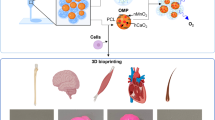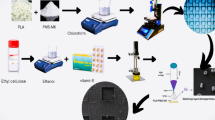Abstract
It has remained a great challenge to design a tissue engineering scaffold for tissue regeneration, which should be suitable for cell adhesion, proliferation and differentiation. One possible solution may be to fabricate the scaffolds with the stable mechanical property, controllable pore size and good interconnectivity, and allowing homogenous cell distribution. This study described the key technology of fabricating three-dimensional (3D) mPEG-PCL-mPEG scaffolds combined with cell-laden gelatin methacrylate (GelMA) hydrogels. Firstly, a dual-nozzle 3D printing system was successfully developed using thermal extrusion coupled with a photo curable technique. Then, the triblock material mPEG-PCL-mPEG was synthesized and evaluated. Subsequently, the fabricated 3D mPEG-PCL-mPEG scaffolds were injected with cell-laden GelMA hydrogels. Finally, the mPEG-PCL-mPEG scaffolds were evaluated. The evaluation results showed that this 3D mPEG-PCL-mPEG scaffolds technology is a potentially powerful approach, which may be used in a variety of tissue engineering applications.










Similar content being viewed by others
References
Abbott A (2003) Cell culture: biology’s new dimension. Nature 424:870–872
Agarwal R, García AJ (2015) Biomaterial strategies for engineering implants for enhanced osseointegration and bone repair. Adv Drug Deliv Rev 94:53–62
Baker BM, Chen CS (2012) Deconstructing the third dimension–how 3D culture microenvironments alter cellular cues. J Cell Sci 125(13):3015–3024
Bernardin JD, Mudawar I, Walsh CB, Franses EI (1997) Contact angle temperature dependence for water droplets on practical aluminum surfaces. Int J Heat Mass Transf 40(5):1017–1033
Bertol LS, Schabbach R, dos Santos LAL (2017) Different post-processing conditions for 3D bioprinted α-tricalcium phosphate scaffolds. J Mater Sci Mater Med 28(10):168
Bose S, Vahabzadeh S, Bandyopadhyay A (2013) Bone tissue engineering using 3D printing. Mater Today 16(12):496–504
Brydone A, Meek D, Maclaine S (2010) Bone grafting, orthopaedic biomaterials, and the clinical need for bone engineering. Proc Inst Mech Eng Part H J Eng Med 224(12):1329–1343
Cohen DL, Lo W, Tsavaris A, Peng D, Lipson H, Bonassar LJ (2010) Increased mixing improves hydrogel homogeneity and quality of three-dimensional printed constructs. Tissue Eng Part C Methods 17(2):239–248
Cuadros TR, Erices AA, Aguilera JM (2015) Porous matrix of calcium alginate/gelatin with enhanced properties as scaffold for cell culture. J Mech Behav Biomed Mater 46:331–342
Do AV, Khorsand B, Geary SM, Salem AK (2015) 3D printing of scaffolds for tissue regeneration applications. Adv Healthcare Mater 4(12):1742–1762
Doblaré M, Garcıa J, Gómez M (2004) Modelling bone tissue fracture and healing: a review. Eng Fract Mech 71(13–14):1809–1840
E ISO 10993-5 (2009) Biological evaluation of medical devices. Part 5: tests for in vitro cytotoxicity. International Organization for Standardization, Geneva
Edep ME, Shirani J, Wolf P, Brown DL (2000) Matrix metalloproteinase expression in nonrheumatic aortic stenosis. Cardiovasc Pathol 9(5):281–286
Erdemli Ö, Usanmaz A, Keskin D, Tezcaner A (2014) Characteristics and release profiles of MPEG-PCL-MPEG microspheres containing immunoglobulin G. Colloids Surf B Biointerfaces 117:487–496
Fillingham Y, Jacobs J (2016) Bone grafts and their substitutes. Bone Joint J 98(1 Supple A):6–9
Florencio-Silva R, Sasso GRDS, Sasso-Cerri E, Simões MJ, Cerri PS (2015) Biology of bone tissue: structure, function, and factors that influence bone cells. BioMed Res Int 2015:421746
Fu S, Ni P, Wang B, Chu B, Zheng L, Luo F, Luo J, Qian Z (2012) Injectable and thermo-sensitive PEG-PCL-PEG copolymer/collagen/n-HA hydrogel composite for guided bone regeneration. Biomaterials 33(19):4801–4809
Gibbs DM, Vaezi M, Yang S, Oreffo RO (2014) Hope versus hype: what can additive manufacturing realistically offer trauma and orthopedic surgery? Regen Med 9(4):535–549
Gruskin E, Doll BA, Futrell FW, Schmitz JP, Hollinger JO (2012) Demineralized bone matrix in bone repair: history and use. Adv Drug Deliv Rev 64(12):1063–1077
Guillotin B, Guillemot F (2011) Cell patterning technologies for organotypic tissue fabrication. Trends Biotechnol 29(4):183–190
Hollister SJ (2005) Porous scaffold design for tissue engineering. Nat Mater 4(7):518
Holzwarth JM, Ma PX (2011) 3D nanofibrous scaffolds for tissue engineering. J Mater Chem 21(28):10243–10251
Jiang CP, Chen YY, Hsieh MF (2013a) Biofabrication and in vitro study of hydroxyapatite/mPEG–PCL–mPEG scaffolds for bone tissue engineering using air pressure-aided deposition technology. Mater Sci Eng C 33(2):680–690
Jiang CP, Chen YY, Hsieh MF, Lee HM (2013b) Solid freeform fabrication and in vitro response of osteoblast cells of mPEG-PCL-mPEG bone scaffolds. Biomed Microdevice 15(2):369–379
Jiankang H, Dichen L, Yaxiong L, Bo Y, Hanxiang Z, Qin L, Bingheng L, Yi L (2009) Preparation of chitosan–gelatin hybrid scaffolds with well-organized microstructures for hepatic tissue engineering. Acta Biomater 5(1):453–461
Kricheldorf HR, Kreiser-Saunders I, Boettcher C (1995) Polylactones: 31. Sn (II) octoate-initiated polymerization of l-lactide: a mechanistic study. Polymer 36(6):1253–1259
Lietman SA, Tomford WW, Gebhardt MC, Springfield DS, Mankin HJ (2000) Complications of irradiated allografts in orthopaedic tumor surgery. Clin Orthop Relat Res 375:214–217
Lin RZ, Chen YC, Moreno-Luna R, Khademhosseini A, Melero-Martin JM (2013) Transdermal regulation of vascular network bioengineering using a photopolymerizable methacrylated gelatin hydrogel. Biomaterials 34(28):6785–6796
Liu X, Smith LA, Hu J, Ma PX (2009) Biomimetic nanofibrous gelatin/apatite composite scaffolds for bone tissue engineering. Biomaterials 30(12):2252–2258
Martin I, Wendt D, Heberer M (2004) The role of bioreactors in tissue engineering. Trends Biotechnol 22(2):80–86
Mouriño V, Boccaccini AR (2010) Bone tissue engineering therapeutics: controlled drug delivery in three-dimensional scaffolds. J R Soc Interface 7(43):209–227
Murphy SV, Atala A (2014) 3D bioprinting of tissues and organs. Nat Biotechnol 32(8):773
Neufurth M, Wang X, Wang S, Steffen R, Ackermann M, Haep ND, Schröder HC, Müller WEG (2017) 3D printing of hybrid biomaterials for bone tissue engineering: calcium-polyphosphate microparticles encapsulated by polycaprolactone. Acta Biomater 64:377–388
Nichol JW, Koshy ST, Bae H, Hwang CM, Yamanlar S, Khademhosseini A (2010) Cell-laden microengineered gelatin methacrylate hydrogels. Biomaterials 31(21):5536–5544
Nijenhuis A, Grijpma D, Pennings A (1992) Lewis acid catalyzed polymerization of l-lactide. Kinetics and mechanism of the bulk polymerization. Macromolecules 25(24):6419–6424
Occhetta P, Visone R, Russo L, Cipolla L, Moretti M, Rasponi M (2015) VA-086 methacrylate gelatine photopolymerizable hydrogels: a parametric study for highly biocompatible 3D cell embedding. J Biomed Mater Res Part A 103(6):2109–2117
Sachlos E, Reis N, Ainsley C, Derby B, Czernuszka J (2003) Novel collagen scaffolds with predefined internal morphology made by solid freeform fabrication. Biomaterials 24(8):1487–1497
Schneider OD, Weber F, Brunner TJ, Loher S, Ehrbar M, Schmidlin PR, Stark WJ (2009) In vivo and in vitro evaluation of flexible, cottonwool-like nanocomposites as bone substitute material for complex defects. Acta Biomater 5(5):1775–1784
Smith IO, McCabe LR, Baumann MJ (2006) MC3T3-E1 osteoblast attachment and proliferation on porous hydroxyapatite scaffolds fabricated with nanophase powder. Int J Nanomed 1(2):189
Stephens J, Cooper JA, Phelan F, Dunkers JP (2007) Perfusion flow bioreactor for 3D in situ imaging: investigating cell/biomaterials interactions. Biotechnol Bioeng 97(4):952–961
Strong DM, Friedlaender GE, Tomford WW, Springfield DS, Shives TC, Burchardt H, Enneking W, Mankin HJ (1996) Immunologic responses in human recipients of osseous and osteochondral allografts. Clin Orthop Relat Res 326:107–114
Subia B, Kundu J, Kundu S (2010) Biomaterial scaffold fabrication techniques for potential tissue engineering applications. Tissue engineering. InTech2010, London
Tang D, Tare RS, Yang LY, Williams DF, Ou KL, Oreffo ROC (2016) Biofabrication of bone tissue: approaches, challenges and translation for bone regeneration. Biomaterials 83:363–382
Ullah F, Othman MBH, Javed F, Ahmad Z, Akil HM (2015) Classification, processing and application of hydrogels: a review. Mater Sci Eng C 57:414–433
Van Den Bulcke AI, Bogdanov B, De Rooze N, Schacht EH, Cornelissen M, Berghmans H (2000) Structural and rheological properties of methacrylamide modified gelatin hydrogels. Biomacromol 1(1):31–38
Yao X, Panichpisal K, Kurtzman N, Nugent K (2007) Cisplatin nephrotoxicity: a review. Am J Med Sci 334(2):115–124
Yaszemski MJ, Payne RG, Hayes WC, Langer R, Mikos AG (1996) Evolution of bone transplantation: molecular, cellular and tissue strategies to engineer human bone. Biomaterials 17(2):175–185
Yuan Y, Lee TR (2013) Contact angle and wetting properties, surface science techniques. Springer, Berlin, pp 3–34
Zhu N, Chen X (2013) Biofabrication of tissue scaffolds. Advances in biomaterials science and biomedical applications. InTech2013, London
Acknowledgements
This work was supported by MOST of Taiwan grant (106-2221-E-150-001) and NSFC (Natural Science Foundation of China) project grant (No.81671928). LPW is supported by National Health and Medical Research Council (NHMRC) Fellowship (No. APP1158402), Channel 7 Children’s Research Foundation grant (No.181662), and NSFC (No.81671928).
Author information
Authors and Affiliations
Corresponding authors
Additional information
Publisher's Note
Springer Nature remains neutral with regard to jurisdictional claims in published maps and institutional affiliations.
Rights and permissions
About this article
Cite this article
Dong, J., Yang, YD., Wang, L. et al. Fabrication of three-dimensional mPEG-PCL-mPEG scaffolds combined with cell-laden gelatin methacrylate (GelMA) hydrogels using thermal extrusion coupled with photo curable technique. Microsyst Technol 25, 3339–3355 (2019). https://doi.org/10.1007/s00542-018-4190-x
Received:
Accepted:
Published:
Issue Date:
DOI: https://doi.org/10.1007/s00542-018-4190-x




